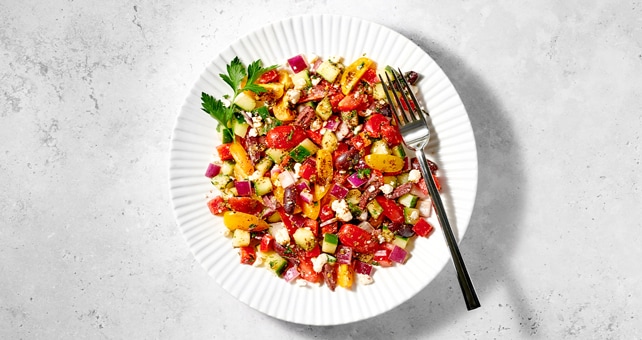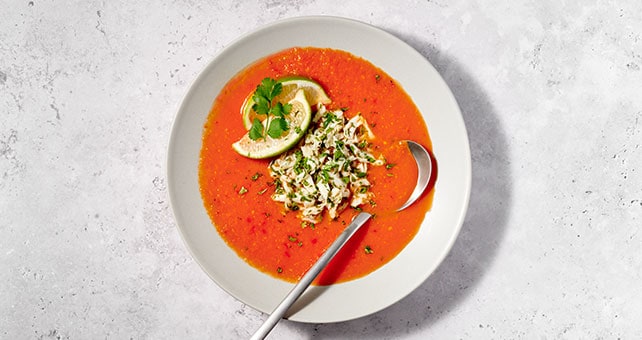Published July 1, 2024
The sheer amount of information surrounding hydration can make distinguishing fact from fiction a challenge. But understanding the basics, like which beverages to drink or foods to eat, is vital to staying hydrated and healthy.
Refreshing recipes.
Our dietitians can assist you on your journey to feeling your best. Join us as we debunk three of the most common hydration myths.
Myth #1: Everyone needs the same amount of water.
All sorts of factors contribute to how much water an individual needs. Physical activity, gender, alcohol intake, health status, exposure to extreme temperatures, and excessive loss of body fluids all impact your personal hydration needs.1 In general, women need about 11.5 cups of water per day, and men need 15.5 cups. However, some of that water will come from foods, so women should aim to drink 9 cups of water per day, and men 13 cups per day.2 If you need help assessing your fluid needs, reach out to a physician or registered dietitian nutritionist.
Myth #2: You don’t need to drink any more water if you’re not thirsty.
While there’s some truth to this myth, it is not foolproof. Furthermore, we become less able to rely on thirst as we age. There are more bodily signals that you need to consume liquids than just thirst. For example, fatigue, confusion, and mood changes can all be signs of mild dehydration.1
Because water is so crucial to the body—and makes up about 60% of it2—dehydration can also impact joint pain, kidney stone development, heart health, and even headaches.3 Have you ever heard that drinking some water can help soothe your headache? We are here to confirm that is true.
Myth #3: You can only hydrate by drinking fluids.
Not only is this not the case, but people generally consume about 20% of their daily water intake via food.2 Some foods, like watermelon, may be a little more obvious. In fact, one cup of watermelon provides just over a half cup of water. Some other foods comprised of 80–99% water include apples, carrots, pineapple, cantaloupe, celery, and cooked squash.4 Check out the chart below to learn more about the water content of various foods.
| Food | Serving Size | Water Content/Serving* |
|---|---|---|
| Soup, broth based | 1 cup | 230 mL |
| Cottage Cheese | 1 cup | 185 mL |
| Broccoli, cooked | 1 cup | 170 mL |
| Watermelon | 1 cup | 140 mL |
| Peaches, raw | 1 medium | 133 mL |
| Berries, raw | 1 cup | 130 mL |
| Banana, raw | 1 medium | 90 mL |
*1 cup = ~240 mL of water
We offer recipes that are geared toward hydration. Check out our Village-Style Chopped Salad, which is packed with hydrating veggies, or our Watermelon Soup with Lump Crab. We also offer a variety of beverages to diversify your liquid intake. Learn more about our Better Choice shelf tag program and the drinks we’ve identified as smart hydration options.
However you choose to get your fluid intake, we invite you to allow Publix to be a part of your health journey. If you have any questions, please feel free to email our team of dietitians.
For the love of you.
Choosing how you eat is uniquely personal. It’s about your needs, your preferences, and your goals. As your wellness ally, we’re in your corner with fresh ideas, recipes, and wellness icons that make it easier to shift toward wiser food choices. It’s all about you, at your very best.
Sources.
1Water. Harvard T.H. Chan School of Public Health. Accessed March 13, 2024.
2Gordon, Barbara. How Much Water Do You Need? EatRight.org. June 23, 2022.
310 Reasons Why Hydration Is Important. National Council on Aging. January 16, 2024.
4What's in the Foods You Eat Search Tool. USDA Agricultural Research Service. Accessed March 13, 2024.

 You are about to leave publix.com and enter the Instacart site that they operate and control. Publix’s delivery and curbside pickup item prices are higher than item prices in physical store locations. Prices are based on data collected in store and are subject to delays and errors. Fees, tips & taxes may apply. Subject to terms & availability. Publix Liquors orders cannot be combined with grocery delivery. Drink Responsibly. Be 21. For prescription delivery, log in to your pharmacy account by using the Publix Pharmacy app or visiting
You are about to leave publix.com and enter the Instacart site that they operate and control. Publix’s delivery and curbside pickup item prices are higher than item prices in physical store locations. Prices are based on data collected in store and are subject to delays and errors. Fees, tips & taxes may apply. Subject to terms & availability. Publix Liquors orders cannot be combined with grocery delivery. Drink Responsibly. Be 21. For prescription delivery, log in to your pharmacy account by using the Publix Pharmacy app or visiting 
